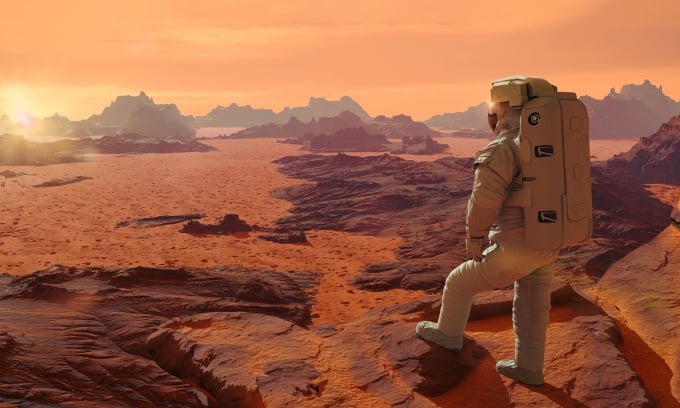If walking along the equator, astronauts need to travel 21,400 km to complete one full circuit around Mars and it takes 4,290 hours if walking continuously.

Simulation of an astronaut standing and observing on Mars. Photo: dottedhippo/iStock
Humans have long been interested in Mars, and NASA has ambitious plans to send astronauts to the planet in the next few decades. Since Mars has no oceans or other bodies of water on its surface, could astronauts walk around the red planet? How long would such a trip take?
“Basically, we’re going to need two parameters,” says Erdal Yigit, an associate professor of astrophysics at George Mason University who studies planetary atmospheres. Those two parameters are the astronaut’s velocity (speed and direction) and the distance traveled.
Traveling along the Martian equator would require astronauts to travel 21,400 km to complete a full circuit around the planet. Traveling over the poles would shave 160 km off the trip, but the extreme cold would be a bigger challenge than the harsh conditions on the rest of Mars, Yigit said.
The astronauts will be traveling at about 5 km/h, which is the average walking speed on Earth, along the equator. Although Mars' gravity is only about 40% of Earth's, Yigit doesn't think walking on the red planet will be much different. Like any hiker, astronauts will need to carry a large amount of supplies, including oxygen, water, and food, and wear a heavy spacesuit.
If an astronaut were to walk continuously around Mars at the above speed, the calculation would be very simple: just divide the distance by the speed. The result would be about 4,290 hours. A day on Mars, called a sol, is about 24.7 hours. Thus, it would take about 174 sols to walk continuously around the red planet, equivalent to more than 1/4 of a Martian year (a Martian year is 668.6 sols).
But of course, no one can walk continuously, regardless of the planet. Even if they carry enough oxygen, water, food, and can eat while walking, astronauts still have to stop to sleep. If they sleep about 8 hours a night, the trip will take about 56 sols. If astronauts stop 4 or 5 hours per sol to eat, rest, change clothes, shower, set up and take down camp, that will take another 30-35 sols.
So a more realistic estimate is that the trip would take at least 265 sols, about 40% of a Martian year. However, this estimate still doesn’t take into account other obstacles, such as the rugged terrain. Mars has many mountains, some taller than any on Earth, as well as valleys, craters, and other difficult geological formations.
A walk around Mars is not likely to happen anytime soon. People have walked around Earth, though not all the way around because of the oceans. But humans have only walked on a small part of the Moon, despite having visited it many times. Walking so far and for so long on Mars would also pose logistical problems, like carrying enough food, water, oxygen, and exposure to radiation.
Yigit said it was unlikely that humans would ever circumnavigate Mars, but putting astronauts on the surface would still have many advantages over rovers. Robots are susceptible to dust and electrical problems, he said. But with astronauts, even if problems arise, they can find a solution.
Thu Thao (According to Space )
Source link


![[Photo] Binh Trieu 1 Bridge has been completed, raised by 1.1m, and will open to traffic at the end of November.](https://vphoto.vietnam.vn/thumb/1200x675/vietnam/resource/IMAGE/2025/10/2/a6549e2a3b5848a1ba76a1ded6141fae)


































































































Comment (0)